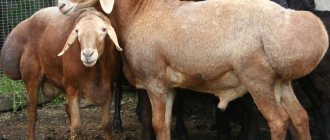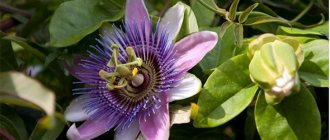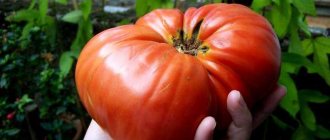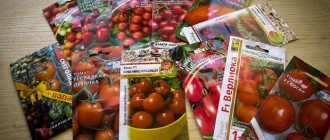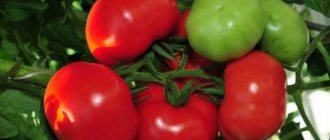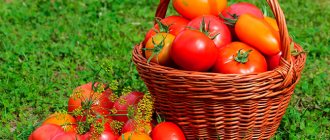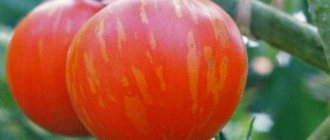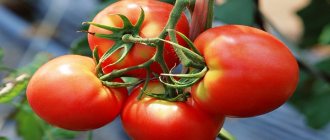In recent years, the usual image of tomatoes has been changing, taking on bizarre forms. The variety of varieties reaches fantastic levels, although two decades ago this seemed completely impossible. The color scheme and unique appearance turn an ordinary tomato into an exotic vegetable. Imagine for yourself, a large elongated red pepper actually turns out to be a tomato! Or it looks like a small black bunch of grapes, but it tastes like a cherry tomato!
So, we invite exotic lovers to get acquainted with a unique variety - the Pepper tomato.
Characteristics and description of the variety
The tomato was included in the State Register of Breeding Achievements in 2001 . There are several varieties of pepper tomatoes that differ not only in color and appearance, but also in growing conditions.
Pepper tomatoes - varietal variety
The variety of colors of pepper varieties allows you to grow not only red, but also yellow, pink and orange tomatoes in your garden beds.
Pink
Belongs to the work of Novosibirsk breeders. The variety is relatively recent, it is only 4 years old. It is characterized by compact bushes and belongs to the determinant type.
Despite the small growth, the quantitative indicator of fruiting reaches 10-13 kg per 1 sq. m . The fruits are large, the average weight of one is 150-250 g. The color is deep crimson, pleasant, and the excellent sugar taste can successfully compete with any sweet fruit. The species is early ripening; fruit harvesting begins 100 days after planting.
Orange
The variety appeared thanks to the efforts of agro breeders. The type is indeterminate and requires obligatory gartering and regular pinching. The main difference is the ability of seedlings to not stop growing and developing in low light conditions.
The average weight of vegetables is 130-170 g, the taste is excellent, sweet . The species is mid-season, but with a high fruiting rate, from 1 sq. m harvest 8-9 kg. Plants adapt well to unfavorable conditions, so they are grown outdoors in regions with temperate climates.
Yellow
The author and originator of the variety is Lyubov Anatolyevna Myazina, who has a significant number of tomato crops to her credit.
The type is indeterminate, mid-season. It is distinguished by strong immunity to major diseases and increased heat resistance . The fruits grow small, up to 80 g, with a bright yellow color that resembles the reflection of a sunbeam. The taste is excellent, sweet, but you won’t be able to collect a lot of vegetables: for 1 sq. m is formed no more than 3-4 kg.
In addition to those listed, there are several more similar varieties - Pepper-shaped Krepysh, Gigant, Raspberry and Red.
THE BEST TOMATOES FOR CANNING ARE PEPPER YELLOW.
Distinctive features
The type of the main variety of Pepper tomatoes is indeterminate, the height of the bush is 1.5-2 m. The foliage is strong, the leaves are large. The first brush is placed above the 6th leaf, the subsequent ones - every 3 leaves. Each cluster bears up to 6 fruits.
The ripening period is average, from the moment of sowing to full ripening, 110-120 days pass . Fruiting is extended, lasting until the end of October. Recommended for cultivation in open ground and in greenhouse conditions.
Productivity is high , from 1 sq. m harvest 6-8 kg, subject to planting 3-4 seedlings per 1 sq. m.
The culture is resistant to dangerous diseases of the nightshade family.
The indeterminate type implies unlimited growth of the main stem, which means that the plants require staking and regular pinching. To mark the growth point, the top of the head is pinched.
It will be interesting:
Easy to care for and rich in yield, the “Pretty” tomato
Ideal for canning tomato “Japanese truffle”
Tomato "Valentina" - a variety for the Russian climate
Fruit characteristics
The photo shows a yellow pepper tomato.
The average weight of one fruit is 110-120 g . The shape is elongated, pepper-shaped, the color is bright red. The taste is excellent, sweet, reminiscent of the taste of sweet pepper. The pulp is juicy, fleshy, there are few seeds. The peel is dense and not prone to cracking.
The purpose is universal; tomatoes are used for fresh consumption, pickling, and canning . Ripe vegetables are frozen and dried thanks to their tough skin. They are also used for processing into tomato products, producing excellent pastes and juices.
Tomatoes are distinguished by their high shelf life and the ability to withstand long-distance transportation without losing their presentation.
Pest and disease control
The pepper tomato is classified as a hybrid, during the breeding of which all deficiencies at the genetic level were eliminated. Varieties of this type of tomato are resistant to common diseases and pests.
Late blight is considered the only problem that arises in conditions of high humidity.
The leaves of diseased plants dry out and turn black. Treatment begins immediately, otherwise the bush will die and infect neighboring plants. Ash spraying, which is carried out 3 times per season, helps prevent late blight.
Half a bucket of ash is diluted in 10 liters of water, mixed and left for 72 hours. Take 30 liters of the settled solution, add 30-35 g of soap (laundry or liquid) and spray the plantings.
():
If a tomato has become infected with late blight, then the main task is to prevent this disease from spreading to neighboring bushes. For this purpose, both mechanical methods of protection are carried out - removing the lower leaves, leaves with dark spots that have appeared, as well as chemical and biological ones. Currently, there is a wide range of modern drugs to suppress late blight: Previkur Energy, Ridomil Gold, Trichoplan, Profit.
How to grow seedlings
Sowing seeds for seedlings begins 2 months before planting in the ground . Before sowing, the seeds undergo special preparation.
Seed preparation
The photo shows a pink peppercorn tomato.
The seed material is laid out on the table one at a time and carefully inspected for visible defects. It is then checked for emptiness by immersing it in a saline solution for 10 minutes.
Those seeds that float to the surface are not suitable for planting. The remaining grains are placed in a weak manganese solution for 30 minutes. In this way, the grains undergo disinfection, which has a positive effect on the further development of the seed material.
To improve germination, seeds are soaked for 10 hours in a growth stimulator. The swollen ones can be sown in the ground.
Attention! High-quality seed preparation ensures healthy seedling growth.
Container and soil
The soil is prepared from turf soil and humus in equal quantities. A little washed river sand, 1 teaspoon of superphosphate and 3 teaspoons of wood ash are added to the resulting mixture. After thoroughly mixing all the components, the soil mixture is poured with a hot solution of purple potassium permanganate or steamed in the oven at a temperature of 50°C for 15 minutes.
Reference. Disinfection of prepared soil destroys pathogenic microorganisms that are destructive to seedlings.
The cooled soil is laid out in planting containers , filling them two-thirds. Small drainage holes are made in advance at the bottom of the containers to ensure the drainage of excess moisture.
You can plant in a common wooden box and in separate containers, for example, plastic cups, peat pots or paper honeycombs.
Sowing
Seeds are sown to a depth of 1.5 cm with a distance of 2-3 cm from each other . Sprinkle the soil on top, compact it and lightly water it with warm, settled water using a spray bottle. The planting containers are covered with film and left in a warm room at a temperature of 25°C. The film is removed daily to ventilate and moisten the soil as it dries out.
Seedling care
When shoots appear, the film is removed and the containers are moved to the windowsill . Daylight hours for seedlings are at least 12 hours, so additional lighting is installed if necessary.
Water moderately with warm, settled water along the edges of the containers using a shallow watering can. After watering, the soil is loosened carefully, without touching the young roots.
When 2 true leaves appear, the seedlings dive , planting them in separate containers. The picking procedure means shortening the main spine by one third. After picking, the seedlings grow more intensively.
Advice! If growth is poor, seedlings should be fed with liquid fertilizer for tomato seedlings.
2-3 weeks before planting in the ground, the sprouts are hardened by taking them out into the open air for 1 hour. Gradually, the time spent on the street is increased to 12 hours. At the same time, the night temperature in the room where the seedlings are brought is reduced to 13°C.
How to grow tomatoes
After 2 months, the seedlings are ready for transplanting . The soil for the beds is prepared in advance: it is dug up and compost is added.
Landing
Planting pattern : 60 cm – distance between seedlings, 60 cm – row spacing. For 1 sq. m place no more than 4 plants.
After transplantation, the holes are compacted, watered with warm, settled water and the seedlings are left to get used to the new conditions for 2 weeks. Beds for tomatoes are chosen in a sunny place, protected from drafts.
Reference. During adaptation, the plants are not watered or fed.
Further care
Regular watering is established no more than 2 times a week . On hot and dry days, the amount of watering is increased as the soil dries out. Water with settled water, strictly at the root in the morning or evening. After watering, the soil is loosened, removing weeds with roots. Weeding the beds is mandatory, since the weeds are home to a large number of pests and pathogenic spores.
To retain moisture in the beds, they are mulched with peat or straw . Sawdust can also be used as mulch. Mulching your beds not only helps the soil stay moist longer, but also serves as a preventive measure in the fight against pests.
The first feeding is carried out 2 weeks after transplanting the seedlings . Fertilize with a small amount of superphosphate. With slow growth, seedlings are fed with a full range of mineral fertilizers containing mainly nitrogen.
The second feeding is given 3 weeks after the first . Organic matter is used as fertilizer, for example, mullein infusion in a ratio of 1:10. If there is an increased growth of green mass, fertilizing should be based on phosphorus substances.
The third feeding is applied at the time of fruit formation . Plants are fed with a full range of mineral fertilizers.
Reference. During flowering, wood ash is used as additional fertilizing.
Features of cultivation and possible difficulties
To obtain the maximum fruiting rate, the bushes are formed into 2 or 3 stems . All other stepsons are regularly removed, not allowing them to grow more than 5 cm, otherwise the sections will take much longer to heal. They do this in the morning so that the wounds have time to heal by evening. To avoid the development of infections, the cut sites are treated with a weak solution of manganese.
Tall bushes must be tied up , otherwise the stem will not support the weight of the fruit-bearing branches. When transplanting, a wooden or metal support is installed next to each seedling, to which the stem is fixed. As they grow, fruitful branches are also tied to a support.
Care
The characteristics of hybrid plants indicate that they are undemanding in care, but the standard rules should be followed carefully, because compliance with them directly affects productivity.
Basic care recommendations:
- watering. Low-growing pepper tomatoes are moistened when planted in open ground, 7-10 days after planting, during the formation of the ovary and at the end of June. Tall varieties require frequent watering, which is carried out on average 1-2 times every 7 days (depending on weather conditions);
- feeding The primary application of fertilizers (manure or chicken droppings) occurs 10 days after planting, the secondary application - during the period of active flowering (wood ash);
- stepsoning. Tomato bushes require proper formation, as well as the removal of side shoots until they reach 5 cm.
PEPPER TOMATO. VIDEO REVIEW. Olga Chernova July 19.
Description of the tomato variety PEPPER
Pepper tomato
Nuances for open and protected ground
The variety is recommended for cultivation in open ground in the southern regions and in greenhouse conditions in the northern regions . In the middle zone, it is necessary to have covering material on hand in case of a sharp drop in temperature or prolonged rains.
When the temperature drops unexpectedly, the tomato is fed with calcium ions . This is especially necessary when setting fruit, since in cold air they are affected by fungal diseases, for example, blossom end rot. Feeding with calcium protects the ovaries from fungus.
Stop watering 2 weeks before the vegetables ripen , as the increased amount of moisture may cause the fruits to crack.
In August, the tops of plants are pinched . This not only prevents further growth, but also prevents new inflorescences from forming.
Tomato varieties for unfavorable climates
A range of tomatoes specially bred for the Siberian climate. They are resistant not only to coolness and weather changes, but also to diseases.
Tomato Siberian Troika
The Siberian Troika variety is well suited for non-chernozem soils and weather conditions that are not very favorable for tomatoes.
It is grown in the open air, in film shelters, and in unheated greenhouses. The height of the bush is about 60 cm, the yield is up to 5 kg per bush. With a relatively low growth, the variety is large-fruited (150-300 g, up to 15 cm in length). Some gardeners who leave reviews about the Sibirskaya Troika tomato note a slightly later ripening of the fruits compared to other mid-ripening varieties.
Harvesting and application
Harvesting begins in mid-July and, thanks to extended fruiting, lasts until the first frost.
The purpose of ripe tomatoes is universal : they are used fresh and are excellent for decorating various dishes. The durable peel can withstand heat treatment, so vegetables are used for whole-fruit canning. They also do not lose their taste in pickling and marinades. Ripe vegetables are dried, frozen and stuffed.
Tomatoes can withstand long-term storage and long-term transportation.
Advantages and disadvantages
In addition to its unusual appearance, the culture has many advantages :
- good adaptation to weather conditions;
- high fruiting rate;
- ease of care;
- disease resistance;
- variety of subspecies;
- possibility of breeding in all regions;
- excellent taste;
- attractive presentation;
- universal application;
- long storage;
- long transportations.
Negative qualities include the need for gartering and regular pinching.
Brief description of other types
Many varieties are united by only one common characteristic - the shape of the fruit.
pepper giant
The type is indeterminate, up to 2 m high . It takes root equally well both in open beds and in protected ground. The species is mid-season, 110-115 days pass from the emergence of seedlings to full ripening. The genes contain high resistance to diseases of the nightshade family. To obtain the maximum number of fruits, the plant is formed into 2 or 3 stems.
The average weight of ripe vegetables is 150-210 g . The taste is excellent, sweet, the pulp is juicy, there are few seeds. The color is deep red. Thanks to its durable skin, the fruit has a universal purpose. The presentation is preserved for 3-5 weeks. Productivity is high, from 1 sq. m harvest up to 6 kg.
Pepper striped
Determinate type, height – 0.7-1 m . The stem is strong, the foliage is dense. The species is mid-early, 105-110 days pass from the moment of sowing to full ripening. Productivity is high, from 1 sq. m harvest up to 7 kg. It is characterized by increased resistance to diseases. Recommended for cultivation in open ground and in greenhouse conditions. The formation of plants depends on the place of growth: in the open ground they lead to 1 stem, in the greenhouse they leave 2 shoots.
The average weight of vegetables is 100-120 g, the color is red-orange with obvious yellow stripes . Many compare it to the color of a tiger. The taste is excellent, sweet, the flesh is dense, there are few seeds. Ideal for canning, as they look elegant in glass jars. Thanks to the durable skin, they are stored for a long time and can withstand long-term transportation.
Tomato Cuban
The Cuban black tomato belongs to the indeterminate group. The height of a bush in a greenhouse can exceed 2 meters. The pepper-shaped black variety will attract attention with a tall bush with hanging branches containing 8 tomatoes. A large harvest can only be harvested after 120 days, so it is classified as a mid-late variety.
During courtship, the Cuban pepper species involves the installation of a support for tying and removing numerous lateral branches. You can harvest more tomatoes if you form them into two stems.
The fruits are brown-black, pepper-shaped, weigh about 180 g. The fleshy base contains practically no seeds. Good keeping quality is ensured by a dense but delicate skin.
Farmer reviews
Those summer residents who grew the crop in their garden leave positive reviews. Here are some of them :
Anna, Omsk : “I usually plant tomatoes of Siberian selection. But this summer I decided to experiment. The weather was not great, but the Peppers were a great success: sweet, no acid, meaty flesh. There are few seeds. And the vegetables themselves are so beautiful and unusual. They can be used everywhere – both for freezing and drying, and smaller ones can be preserved whole.”
Natalya, Moscow : “I planted a tomato in a greenhouse. The bushes reached two meters. The vegetables ripened unusually, elongated, in the form of huge icicles. And at the break of the pulp the sugar comes out. Themselves juicy and sweet. It’s very convenient to cut them into sandwiches.”

